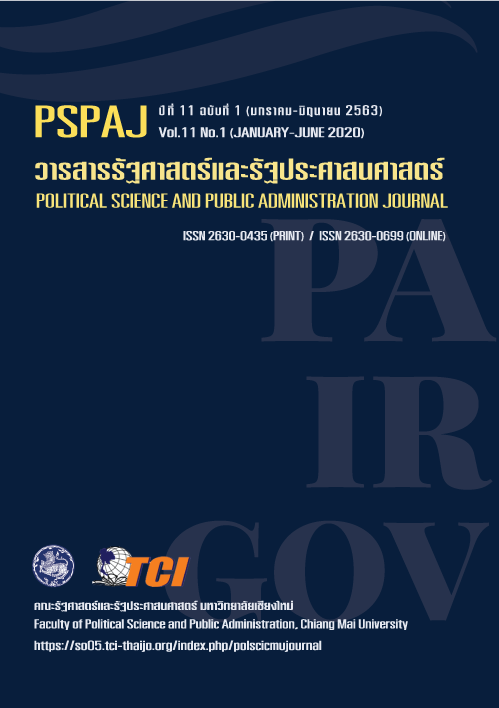Human Resource Management for Startups: Case Studies of Startups in Lifestyle Sector in Chiang Mai Province
Main Article Content
Abstract
The objectives of this study were: (1) to study the characters of human resource management for startups in lifestyle sector, (2) to analyze how human resource management has affected employers and employees, and (3) to study the government reinforcement is necessary in order to improve the efficiency of have human resource management for startups in the lifestyle sector. The study used a qualitative method. Data were collected by in-depth interview method that consisted of 12 key informants, thus 3 sectors: employer, employee in lifestyle startups, and government. Also, a non-participant observation was employed to collect the data. The results of this study showed that: 1) must startups in lifestyle sector did not have formal human resource management department, thus founders will manage human resource by themselves, 2) The effects of human resource management on employers and employees were that employers could select employees that are suitable for organization. Employees have work freely and the opportunity to create their challenging works, and 3) the government reinforcement that necessary to improve efficiency of human resource management for startups in the lifestyle sector acting an intermediary between entrepreneurs and startup employee prospects.
Article Details
- เนื้อหาและข้อมูลที่ลงตีพิมพ์ในวารสารรัฐศาสตร์และรัฐประศาสนศาสตร์ถือเป็นข้อคิดเห็นและความรับผิดชอบของผู้เขียนบทความโดยตรง ซึ่งกองบรรณาธิการวารสารรัฐศาสตร์และรัฐประศาสนศาสตร์ ไม่จำเป็นต้องเห็นด้วย หรือร่วมรับผิดชอบใดๆ
- บทความและข้อมูล ที่ได้รับการตีพิมพ์ในวารสารรัฐศาสตร์และรัฐประศาสนศาสตร์ ถือเป็นลิขสิทธิ์ของวารสาร หากบุคคลหรือหน่วยงานใดต้องการนำข้อมูลไปใช้ประโยชน์ในทางวิชาการ ขอให้อ้างอิงแหล่งที่มาด้วย
References
กรมสรรพากร. (2561). ลักษณะ SMEs. สืบค้นเมื่อ 30 พฤศจิกายน 2560, จาก www.rd.go.th/publish/38056.0.html
กระทรวงอุตสาหกรรม. (2559). ยุทธศาสตร์การพัฒนาอุตสาหกรรมไทย 4.0 ระยะ 20 ปี (พ.ศ. 2560-2579). สืบค้นเมื่อ 25 พฤศจิกายน 2560, จาก www.oie.go.th/view/1/แผนแม่บทอุตสาหกรรม_นโยบาย/TH-TH
กุลชลี พวงเพ็ชร์. (2558). การบริหารทรัพยากรมนุษย์. ปทุมธานี: ยูโอเพ่น.
ณรงค์ ศิริเลิศวรกุล. (2559). สวทช. แนะนำ รู้จัก STARTUP THAILAND ตามแผนยุทธศาสตร์ไทยแลนด์ 4.0. สืบค้นเมื่อ 30 พฤศจิกายน 2560, จาก www.manager.co.th/smes/ViewNews.aspx?NewsID=9590000043461
ณัฏฐพันธ์ เขจรนันทน์. (2545). การจัดการทรัพยากรมนุษย์. กรุงเทพฯ: ธนุชพริ้นติ้ง.
ธรณิศวร์ สุขสวัสดิ์. (2559). ความสัมพันธ์สตาร์ทอัพเซ็นเตอร์ รัชดาภิเษก. (วิทยานิพนธ์สถาปัตยกรรมศาสตรบัณฑิต), มหาวิทยาลัยศรีปทุม.
วิโรจน์ สิมะทองธรรม, สิทธิชัย พรหมสุวรรณ, ฉันทนา จันทร์บรรจง, และวัฒนา สุนทรธัย. (2559). ปัจจัยที่มีอิทธิพลต่อความตั้งใจที่จะลาออกจากงานของพนักงานกลุ่มคนรุ่นใหม่ของธนาคารพาณิชย์ไทย. วารสารวิทยาการจัดการสมัยใหม่, 9(2), 1-12.
ศศิรินทร์ สายะสนธิ. (2560). ทำไม Startup ในไทยไม่ค่อยประสบความสำเร็จ?. สืบค้นเมื่อ 25 พฤศจิกายน 2560, จาก http://www.bangkokbiznews.com/news/detail/760159
สำนักงานจังหวัดเชียงใหม่. (2560). แผนพัฒนาจังหวัดเชียงใหม่ (พ.ศ. 2561-2564). สืบค้นเมื่อ 30 พฤศจิกายน 2560, จาก www.chiangmai.go.th/managing/public/article3
สุพเนตร แสนเสนา, ธิดาทิพย์ บุตรแสง, และกุลยา พัฒนากูล. (2560). ปัจจัยแห่งความสำเร็จของธุรกิจ Startup. ขอนแก่น: คณะวิทยาศาสตร์ มหาวิทยาลัยขอนแก่น.
อรรชกา สีบุญเรือง. (2560). “Startup Thailand 2017” เดินหน้าขึ้นภาคเหนือมุ่ง “ล้านนา”. สืบค้นเมื่อ 30 พฤศจิกายน 2560, จาก www.cm108.com/bbb/topic/3324-23-24-“startup-thailand-2017”-เดินหน้าขึ้นภาคเหนือมุ่ง”ล้านนา”/
MGR Online. (2559). 8 ปัญหาหลัก ฉุดการพัฒนา SMEs-StartUp. สืบค้นเมื่อ 30 ธันวาคม 2560, จาก https://bit.ly/2DytNeo
Blank S. (2010). What is a Startup? Retrieved September 30, 2017, from https://generalassemb.ly/blog/difference-between-a-startup-and-a-small-business/
Crowne, M. (2002). Why Software Product Startups Fail and What to Do About It: Evolution of Software Product Development in Startup Companies. IEEE International Engineering Management Conference, 1, 338-343.
Dessler, G. (2013). Human Resource Management. New Jersey: Prentice-Hall.
Fisher, C. D., Schoenfeldt, L. F., & Shaw, J. B. (1999). Human Resource Management. New York: Houghton Mifflin.
Green, P. (2002). CONTACT: Training a New Generation of Peacebuilders. PEACE & CHANGE, 27(1), 97-105.
Ivancevich, J. M. (2007). Human Resource Management. New York: Mc Graw Hill.
______. (2010). Human Resource Management. Singapore: Mc Graw Hill.
Jaime, N. (2014). These are the 5 Hottest Startup Sectors Whrere Investors are Putting Their EUROS. Retrieved September 30, 2017, from https://startupxplore.com/en/blog/the-5-hottest-startup-sectors-where-investors-are-putting-their-euros/
Mondy, R. W., & Martocchio, J. J. (2016). Human Resource Management. Boston: Pearson.


